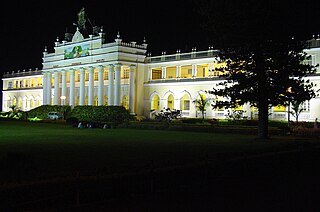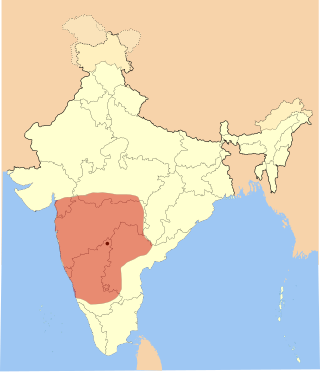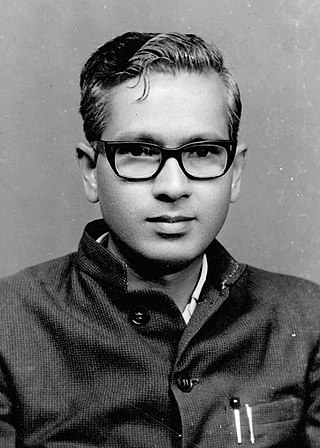| Part of a series on the |
| Culture of Karnataka |
|---|
 |
Later Indian scholars started the study of Kannada inscriptions They contributed from finding to analyzing (including deciphering, publishing) inscriptions.
|
|
|

Kannada, previously also known as Canarese, is a Dravidian language spoken predominantly by the people of Karnataka in southwestern India, with minorities in all neighbouring states. It has around 44 million native speakers, and is additionally a second or third language for around 15 million non-native speakers in Karnataka.

Shravanabelagola is a town located near Channarayapatna of Hassan district in the Indian state of Karnataka and is 144 km (89 mi) from Bengaluru. The Gommateshwara Bahubali statue at Shravanabelagola is one of the most important tirthas in Jainism, one that reached a peak in architectural and sculptural activity under the patronage of Western Ganga dynasty of Talakad. Chandragupta Maurya is said to have died on the hill of Chandragiri, which is located in Shravanabelagola, in 298 BCE after he became a Jain monk and assumed an ascetic life style.

The University of Mysore is a public state university in Mysore, Karnataka, India. The university was founded during the reign of Maharaja Krishnaraja Wadiyar IV and the premiership of Sir M. Visvesvaraya. The university is recognised by the University Grants Commission for offering higher studies degree courses on-campus as well as online. It was inaugurated on 27 July 1916. Its first chancellor was the maharaja himself; the first Vice-Chancellor was H. V. Nanjundaiah. This was the first university outside of British administered Indian provinces, the sixth in the Indian subcontinent as a whole, and the first in Karnataka. It is a state university of the affiliating type, and was deemed autonomous within the Republic of India on 3 March 1956, when it gained recognition from the University Grants Commission.

Rashtrakuta was a royal Indian dynasty ruling large parts of the Indian subcontinent between the 6th and 10th centuries. The earliest known Rashtrakuta inscription is a 7th-century copper plate grant detailing their rule from Manapur, a city in Central or West India. Other ruling Rashtrakuta clans from the same period mentioned in inscriptions were the kings of Achalapur and the rulers of Kannauj. Several controversies exist regarding the origin of these early Rashtrakutas, their native homeland and their language.

The Western Chalukya Empire ruled most of the western Deccan, South India, between the 10th and 12th centuries. This Kannada dynasty is sometimes called the Kalyani Chalukya after its regal capital at Kalyani, today's Basavakalyan in the modern Bidar District of Karnataka state, and alternatively the Later Chalukya from its theoretical relationship to the 6th-century Chalukya dynasty of Badami. The dynasty is called Western Chalukyas to differentiate from the contemporaneous Eastern Chalukyas of Vengi, a separate dynasty. Prior to the rise of these Chalukyas, the Rashtrakuta empire of Manyakheta controlled most of Deccan and Central India for over two centuries. In 973, seeing confusion in the Rashtrakuta empire after a successful invasion of their capital by the ruler of the Paramara dynasty of Malwa, Tailapa II, a feudatory of the Rashtrakuta dynasty ruling from Bijapur region defeated his overlords and made Manyakheta his capital. The dynasty quickly rose to power and grew into an empire under Someshvara I who moved the capital to Kalyani.
The Origin of the Rashtrakuta dynasty has been a controversial topic and has been debated over the past decades by historians. The differing opinions mostly revolve around issues such as the home of the earliest ancestors of the medieval Rashtrakutas, a possible southern migration during the early part of the first millennium and the relationship between the several Rashtrakuta dynasties that ruled small kingdoms in northern and central India and the Deccan in the 6th century - 7th century. Further, the relationship of these medieval Rashtrakutas to the most important and famous dynasty, the Rashtrakutas of Manyakheta of the 8th century - 10th century time period has also been debated. Also contested is whether the Rashtrakutas of Manyakheta were related by ancestry to the early Kannada, Maratha, Reddi communities of the Deccan or other ethnic groups of northern India.
The History of Karnataka goes back several millennia. Several great empires and dynasties have ruled over Karnataka and have contributed greatly to the history, culture and development of Karnataka as well as the entire Indian subcontinent. The Chindaka Nagas of central India Gangas, Rashtrakutas of Manyakheta, Chalukyas of Vengi, Yadava Dynasty of Devagiri were all of Kannada origin who later took to encouraging local languages.
The Siribhoovalaya is a work of multi-lingual literature written by Kumudendu Muni, a Jain monk. The work is unique in that it employs not letters, but is composed entirely in Kannada numerals. The Saangathya metre of Kannada poetry is employed in the work. It uses numerals 1 through 64 and employs various patterns or bandhas in a frame of 729 (27×27) squares to represent alphabets in nearly 18 scripts and over 700 languages.
M. Chidananda Murthy was a Kannada writer, researcher and historian. He was a well-known scholar in Karnataka specializing in the history of Kannada language and ancient Karnataka. He was also known for his campaign to conserve the monuments Hampi and to secure classical language status to Kannada Language. Murthy also articulated that uniform civil code and an anti-conversion law must be enacted by the Government in India.
Hampa Nagarajaiah, popularly known by his pen name Hampanā, is an Indian scholar in Kannada language and Jainism. He was born at Hampasandra Village located in Gowribidanur taluk, Chikkaballapura District in the Indian state of Karnataka. Hampanā is married to Kamala Hampana who also a veteran littérateur.

Ganjam Venkatasubbiah, also known as G. V., was a Kannada writer, grammarian, editor, lexicographer, and critic who compiled over eight dictionaries, authored four seminal works on dictionary science in Kannada, edited over sixty books, and published several papers. Recipient of the Kannada Sahitya Akademi Award and the Pampa Award, Venkatasubbiah's contribution to the world of Kannada Lexicography is vast. His work Igo Kannada is a socio-linguistic dictionary which encompasses an eclectic mix of Kannada phrases, usages, idioms, and serves as a reference for linguists and sociologists alike.
Old Kannada or Halegannada is the Kannada language which transformed from Purvada halegannada or Pre-old Kannada during the reign of the Kadambas of Banavasi.
Extinct Kannada literature is a body of literature of the Kannada language dating from the period preceding the first extant work, Kavirajamarga.

About 25,000 inscriptions found in Karnataka and nearby states belong to historic Kannada rulers, including the Kadambas, the Western Ganga Dynasty, the Rashtrakuta, the Chalukya, the Hoysala and the Vijayanagara Empire. Many inscriptions related to Jainism have been unearthed. The inscriptions found are generally on stone (Shilashasana) or copper plates (Tamarashasana). These Kannada inscriptions are found on historical hero stones, coins, temple walls, pillars, tablets and rock edicts. They have contributed towards Kannada literature and helped to classify the eras of Proto Kannada, Pre Old Kannada, Old Kannada, Middle Kannada and New Kannada. Inscriptions depict the culture, tradition and prosperity of their era. The literature of Ramayana and Mahabharata are transferred through the generations by these inscriptions. The Hazara Rama Temple and Aranmula Parthasarathy Temple are the best examples of temples associated with Kannada inscriptions.

Sondekoppa Ramachandrasastri Ramaswamy is an Indian writer, journalist, biographer, social activist and environmentalist. He has authored more than 50 books and thousand articles both in Kannada and English. He is recipient of the "Karnataka State Sahitya Akademi Award" (1992) for year's best work in social science. In 2015, he was honoured by Hampi University, Karnataka with the 'Nadoja' award. An avid campaigner for environmental issues and people's rights, he has led numerous movements both at state and national level for conservation of vast tracts of rich flora and fauna from ill-planned Government policies. His years as a writer and chronicler brought him under the influence of doyens of literature and public life such as D. V. Gundappa, V. Sitaramayya, Rallapalli Ananta Krishna Sharma, Yadava Rao Joshi and P. Kodanda Rao. His writings essentially mirror the literary, cultural, nationalist and developmental problems that are contemporaneous to the present day scenario. S. R. Ramaswamy is currently the honorary Editor-in-Chief of Kannada monthly "Utthana" and "Rashrothana Sahitya" at Bangalore.

Togere Venkatasubbasastry Venkatachala Sastry, commonly known as T. V. Venkatachala Shastry, is a Kannada-language writer, grammarian, critic, editor and lexicographer. He has authored in excess of 100 books, translations and has edited collections of essays, biographical sketches and felicitation volumes. Recipient of the Kannada Sahitya Akademi Award (honorary), Sastry is an authority on Kannada language grammar and its various facets ranging from the metre scale on which he has written extensively to the history of Kannada literature spanning two millennia.

Sondekoppa Srikanta Sastri was an Indian historian, Indologist, and polyglot. He authored around 12 books, over two hundred articles, several monographs and book reviews over four decades in English, Kannada, Telugu and Sanskrit. These include "Sources of Karnataka History", "Geopolitics of India & Greater India", "Bharatiya Samskruthi" and "Hoysala Vastushilpa". S. Srikanta Sastri was a polyglot well versed in fourteen languages spanning Greek, Latin, Pali, Prakrit, Sanskrit and German among others. He was Head of the Department of History & Indology at Maharaja College, University of Mysore between 1940 and 1960. He was conferred the Kannada Literary Academy award in 1970 and was subsequently honoured by Governor of Karnataka Mohanlal Sukhadia in 1973 during mythic society diamond jubilee function. A Festschrift was brought forth and presented to him during his felicitation function in 1973 titled "Srikanthika" with articles on History and Indology by distinguished scholars. His work on Indus Valley civilization and town planning at Harappa and Mohenjodaro were published in successive articles and drew considerable attention. His articles on The Aryan Invasion theory, the date of Adi Sankaracharya, Oswald Spengler's view on Indian culture, Jaina epistemology, Proto-Vedic religion of Indus Valley Civilization and evolution of the Gandabherunda insignia remain relevant today.

Mysore Hatti Krishna Iyengar was an Indian historian, archaeologist, epigraphist and authority in Indian numismatics. He pioneered the new field of Indology involving the study of Indian culture, history, music and traditions from a historical perspective. He is credited with the discovery of one of the oldest Kannada inscriptions, the Halmidi inscription, dating back to 350 A. D. He also discovered the remains of the city of Isila near Brahmagiri during his excavations at Chandravalli, Chitradurga. The forgotten tomb of Shahaji was traced by M. H. Krishna during his years at the Mysore Archaeological Department. His years at the Archaeology Department saw him churn out many of excavation reports and these were later published in successive volumes of Epigraphia Carnatica. During Krishna's tenure at Bangalore, he was instrumental in cataloguing close to 6000 coins in the archives of the archaeology department there. He was trained at the University College, London under Ernest Arthur Gardner. and would later accompany Sir Flinders Petrie in his excavations in Egypt.

Doddabele Lakshmi Narasimhachar was a Kannada linguist, grammarian, lexicographer, writer, literary critic and editor who taught at the Department of Kannada Language Studies, University of Mysore between 1932 - 1962. His knowledge of Halegannada helped him in reading ancient epigraphic records. He authored four books in Kannada, edited about nine volumes, penned eleven prefaces, wrote nearly hundred articles across three decades, seven monographs in English and outlined introductions to four Kannada works. He presided over the forty first Kannada Sahitya Sammelan held at Bidar in 1960. He was the recipient of the Kannada Rajyotsava Award from the Mysore State. In 1969, his alma mater - University of Mysore bestowed on him an Honorary Doctorate in recognition of a lifetime contribution to the world of Kannada studies.

Haleyuru Srinivasa Krishnaswamy Iyengar was a Kannada columnist, essayist, novelist, critic and teacher of Economics and Commerce studies in Mysore. He is remembered for his character sketches and short essays on personalities and issues of national & international import, in his weekly column "Varada Vyakthi". These appeared in the Kannada magazine "Sudha" continuously for nearly two decades. His literary critique "Kannadadalli Vidambana Sahitya" won him the Kannada Sahitya Akademi Award in 1981. His perspective on elements of Vishistadvaita in the works of Kuvempu were brought forth in his book "Kuvempu Sahityadalli Vishistadvaita – Darshana". H. S. K. penned close to thousand character sketches over two decades. These were later published in four collected volumes. He received the "Rajyotsava Award" from Government of Karnataka in 1997. For his lifetime contribution to Journalism and Kannada literature, the University of Mysore conferred a doctorate degree on him in 2004.